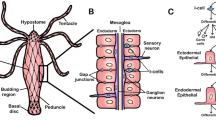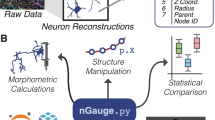Summary
A careful search for groups of nerve cell bodies enclosed within a common connective envelope was made in the spinal ganglia of the lizard and rat using a serial-section technique. Nerve cell bodies sharing a common connective envelope were found to be more common in the lizard (9.4%) than in the rat (5.6%). These nerve cell bodies were arranged in pairs, or, less frequently, in groups of three. At times, they appeared to be in immediate contact, with no intervening satellite cells; at other, they remained separated from one another by a satellite cell sheet. The clusters of nerve cell bodies enclosed within a common connective envelope probably result from the arrest of developmental processes in the spinal ganglion. It is possible that, as a result of the cell arrangement here described, certain neurons electrically influence other sensory neurons at the level of the ganglion.
Similar content being viewed by others
References
Bennett MVL, Auerbach AA (1969) Calculation of electrical coupling of cells separated by a gap. Anat Rec 163:152
Crain SM (1956) Resting and action potentials of cultured chick embryo spinal ganglion cells. J Comp Neurol 104:285–330
De Castro F (1921) Estudio sobre los ganglios sensitivos del hombre en estado normal y patológico. Formas celulares típicas y atípicas. Trab Lab Invest Biol (Madrid) 19:241–340
Dun FT (1955) The delay and blockage of sensory impulses in the dorsal root ganglion. J Physiol (Lond) 127:252–264
Fraentzel O (1867) Bettrag zur Kenntniss von der Structuctur der spinalen und sympathischen Ganglienzellen. Virchows Arch 38:549–558
Harper AA, Lawson SN (1985) Electrical properties of rat dorsal root ganglion neurones with different peripheral nerve conduction velocities. J Physiol (Lond) 359:47–63
Holmgren E (1901) Bettrage zur Morphologie der Zelle. I. Nervenzellen. Anat Hefte 18:267–325
Hossack J, Wyburn GM (1954) Electron microscopic studies of spinal ganglion cells. Proc R Soc Lond [Biol] 65:239–250
Ito M (1959) An analysis of potentials recorded intracellularly from the spinal ganglion cell. Jpn J Physiol 9:20–32
Ito M, Saiga M (1959) The mode of impulse conduction through the spinal ganglion. Jpn J Physiol 9:33–42
Kirk EJ (1974) Impulses in dorsal spinal nerve rootlets in cats and rabbits arising from dorsal root ganglia isolated from the periphery. J Comp Neurol 155:165–176
Koerber HR, Druzinsky RE, Mendell LM (1988) Properties of somata of spinal dorsal root ganglion cells differ according to peripheral receptor innervated. J Neurophysiol 60:1584–1596
Korn H, Faber DS (1979) Electrical interactions between vertebrate neurons: field effects and electrotonic coupling. In: Schmitt FO, Worden FG (eds) The neurosciences: fourth study program. MIT Press, Cambridge, Mass, pp 333–358
Mac Leod P (1958) Le délai dans la conduction de l'influx dans la ganglion rachidien. J Physiol (Paris) 50:386–387
Mannu A (1935) Ricerche sulla evoluzione dei neuroni nei gangli spinali dei mammiferi (Bos taurus). Riv Biol 19:225–250
Mayor HD, Hampton JC, Rosario B (1961) A simple method for removing the resin from epoxy-embedded tissue. J Biophys Biochem Cytol 9:909–910
McCracken RM, Dow C (1973) An electron microscopic study of normal bovine spinal ganglia and nerves. Acta Neuropathol (Berl) 25:127–137
Nawzatzky I (1933) Zur Kenntnis der Farbspeicherung in peripherischen Ganglien der Maus. Z Zellforsch 20:229–236
Pannese E (1974) The histogenesis of the spinal ganglia. Adv Anat Embryol Cell Biol 47/5:1–97
Pannese E (1981) The satellite cells of the sensory ganglia. Adv Anat Embryol Cell Biol 65:1–111
Peacock JH, Nelson PG, Goldstone MW (1973) Electrophysiologic study of cultured neurons dissociated from spinal cords and dorsal root ganglia of fetal mice. Dev Biol 30:137–152
Rose RD, Koerber HR, Sedivec MJ, Mendell LM (1986) Somal action potential duration differs in identified primary afferents. Neurosci Lett 63:259–264
Rosenbluth J (1962) Subsurface cisterns and their relationship to the neuronal plasma membrane. J Cell Biol 13:405–422
Sato M, Austin G (1961) Intracellular potentials of mammalian dorsal root ganglion cells. J Neurophysiol 24:569–582
Scharf JH (1958) Sensible Ganglien. In: Möllendorff W v, Bargmann W (eds) Handbuch der mikroslopischen Anatomic des Menschen, vol 4/3. Springer, Berlin Göttingen Heidelberg, pp 201–202 and 213–215
Scott BS, Engelbert VE, Fisher KC (1969) Morphological and electrophysiological characteristics of dissociated chick embryonic spinal ganglion cells in culture. Exp Neurol 23:230–248
Svaetichin G (1951) Electrophysiological investigations on single ganglion cells. Acta Physiol Scand 24 [Suppl 86]:23–57
Tagini G, Camino E (1973) T-shaped cells of dorsal ganglia can influence the pattern of afferent discharge. Pflügers Arch 344:339–347
Varon S, Raiborn C (1971) Excitability and conduction in neurons of dissociated ganglionic cell cultures. Brain Res 30:83–98
Wall PD, Devor M (1983) Sensory afferent impulses originate from dorsal root ganglia as well as from the periphery in normal and nerve injured rats. Pain 17:321–339
Wyburn GM (1958) The capsule of spinal ganglion cells. J Anat 92:528–533
Yoshida S, Matsuda Y (1979) Studies on sensory neurons of the mouse with intracellular-recording and horseradish peroxidase-injection techniques. J Neurophysiol 42:1134–1145
Author information
Authors and Affiliations
Rights and permissions
About this article
Cite this article
Pannese, E., Ledda, M., Arcidiacono, G. et al. Clusters of nerve cell bodies enclosed within a common connective tissue envelope in the spinal ganglia of the lizard and rat. Cell Tissue Res 264, 209–214 (1991). https://doi.org/10.1007/BF00313957
Accepted:
Issue Date:
DOI: https://doi.org/10.1007/BF00313957




